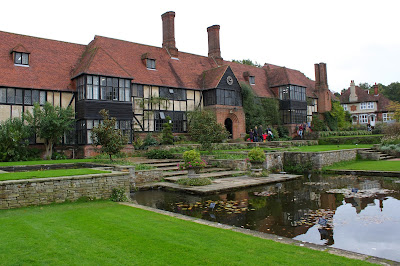Throughout the year, there are a series of garden study days at Great Dixter. Last week, Fergus taught a day-long class on exotic gardening. A couple of co-workers and I were invited to join the group. Exotic gardening could loosely be defined as: the combination of coastal, tropical and/or cacti and succulent plants, often non-native, tender species, used to create a unique, long-season display. This isn't a book definition, but it provides some basic parameters. In reality, there are numerous variations to exotic gardening.
Dahlia 'Chimborazo' in the Exotic Garden
Although difficult to imagine, the Exotic Garden at Great Dixter was once a rose garden. Influenced by their travels, Christopher Lloyd ("Christo") and head gardener, Fergus Garrett, wanted to create a space for late-season interest and color (into September and October). In the early 1990's, they began removing all but 11 of the best roses, while planting Cannas, Dahlias, Bananas and the like. Every year, they tweaked it, adding new plants, while removing others. I was able to appreciate the year-to-year changes even more after seeing Fergus's slides.
The space they chose for the Exotic Garden is appropriate. Framed by hedges and the building, there is a certain feeling of enclosure. The space is made up of several different beds, divided by Yorkstone paths, which absorb heat in the summer, adding to the conducive environment. This layout allows for a variety of views and focal points. Because you can't see the entire space in one glance, visitors must move through the space, brushing against the plants and interacting with the garden.
Colocasia 'Black Magic' (left) definitely provides character
According to Fergus, "anything goes" in this garden space. He says he wants to "create an other-worldly garden." Plants with character are selected for this garden, specifically the bold, unusual or quirky ones. However, creating connectivity is still important, in order to bring the space together.
One of Fergus's central philosophies is trying different things from one season to another. Although the Exotic Garden is currently composed of roughly 60% tender plants and 40% hardy plants, you could create a composition of only hardy plants. There are no rules---experiment! Because our garden consists of so many tender plants, it is more labor-intensive. Not only do we conduct 2-3 plantings during the year in the Exotic Garden, (filling in gaps or enhancing spaces) we must also lift most of the plants and bring them indoors for the winter. Is it worth all the time and effort? We certainly think so, but you can decide what works best for you!
It's definitely worth the work!




















































